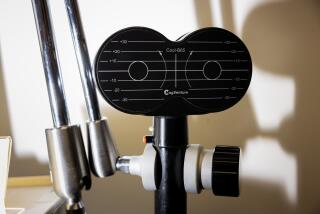Electroshock: First glimpse of how it works adds clues to depression
- Share via
Electroconvulsive therapy, or ECT, has been used to jolt severely and persistently depressed patients from their disabling mood state for more than seven decades. And while the treatment is considered highly effective, psychiatrists and mental health researchers have long scratched their heads over the question of just how the practice works to banish crippling depression, sometimes after just a few sessions.
They are clueless no more. A new study sheds light for the first time on what ECT therapy does in the brain. And in so doing, researchers say they may have found a promising and more objective new way to diagnose depression — by looking for evidence of too much crosstalk among distinct networks that make up the brain.
In a report published Monday in the Proceedings of the National Academies of Science (PNAS), a group of researchers in Scotland used a brain scanner that watches the brain at work — called fMRI — to peer into the brains of nine severely depressed patients before and after they received electroconvulsive therapy. The neuroscientists first divided up the brain into a complex jigsaw puzzle of component pieces and then measured the electronic message traffic among those pieces to see how the patterns changed before and after ECT.
A growing body of promising research had given the researchers some suspicions about what they’d see. In depression and several other psychiatric disorders, studies have begun to detect a pattern of “hyperconnectivity” between three widely scattered “networks” in the brain: the network of structures in which we process emotion and response to threats (“the affective network”); the network of structures that allows us to focus our attention, to reason and make higher-order judgments (“the cognitive control network”); and a cluster of regions that comes alive as a group when our minds are at rest — brain structures that help us ponder the intentions and mental states of others, consider our personal experiences and assess our emotions (dubbed the “default mode network”).
In healthy people, those three networks more or less take turns being dominant, and kibitzing from the others is suppressed, as circumstances dictate: When we’re working on a mental task that requires our full attention, the cognitive control circuits become active, shushing interference from the others; if a snake slithered into the room, regions of the affective network would come alive, and thoughts of the mental task we had just been involved in would be put on hold as our threat sensors take charge. Later, when the danger has passed and the mind is not otherwise engaged, the default mode network kicks into gear, allowing us to sort through our personal memories, contemplate our social relationships and reflect upon what a shock it was that that snake suddenly appeared.
In depressed people, the chatter among those three networks appears to be too noisy: A depressed person’s concentration at work is easily broken by ruminations about relationship troubles; a social slight that a healthy person might easily dismiss feels like the emotional equivalent of a rampaging elephant to a depressed person; feelings of anxiety, guilt or shame distort judgments about everything.
On the fMRI, these hallmark symptoms of severe depression look like a traffic grid in which all the lights are stuck on green: There’s too much crosstalk (“hyperconnectivity” in the language of neuroscientists) among the brain’s distinct networks. And one other quirk appears to characterize the depressed brain: the dorsolateral prefrontal cortex — an area associated with cognitive control and conflict monitoring — is in constant communication with all the brain regions of the three big networks. It may be a central hub or switching station for all their crosstalk, or it may be constantly activated in a vain effort to override the chaos and restore order. Scientists haven’t been sure.
Electroconvulsive therapy (the “One Flew Over the Cuckoo’s Nest” moniker “electroshock therapy” is not in wide use anymore) actually succeeds in restoring that order. After several sessions of ECT, the researchers in Scotland began to see a healthy pattern of brain networks “taking turns” again in subjects’ brains. ECT appeared to have restored the traffic lights in the mental grids of their brains.
Under the effects of a strong sedative and a muscle relaxant, researchers placed electrodes roughly at each subject’s temples, on both sides. They administered ECT therapy — a pulse of electrical charge sufficient to induce an electrical storm (a seizure) in the brain. Twice a week, subjects got the ECT until they reported their depressive symptoms had lifted (on average, it took 8.3 sessions).
After just a few sessions of ECT, the researchers began to see the patterns of hyperconnectivity reduced and, in particular, saw that the dorsolateral prefrontal cortex was not in constant communication with far-flung regions of the brain. And as evidence of crosstalk in the brain declined, subjects were likely to report greater relief of their depressive symptoms.
The particularly dramatic reduction of “hyperconnectivity” in the dorsolateral prefrontal cortex led researchers to suggest that that brain structure may indeed be a hub of activity linking disparate brain networks and that ECT’s effectiveness in restoring patients’ emotional balance may be due to its effects on the dorsolateral prefrontal cortex.
The ECT-induced changes in the brain also may help to explain why ECT patients often suffer from memory and other cognitive problems, often for months after treatment, the researchers wrote. The dorsolateral prefrontal cortex plays an important role in the transfer of memories from short-term to long-term storage, as well as helping to focus attention among competing demands. If ECT dampens the structure’s activity, the authors wrote, such effects might be anticipated.







